A Guide to Planting Tulips in August for Beginner Gardeners
Tulips are spring flowers with sophisticated bud shapes of various shades. They are one of the first to delight summer residents after a long, cold winter. To enjoy abundant and long-lasting flowering, it is important to follow the bulb planting recommendations. The procedure is carried out in August – November, depending on the climate in the region.
Is it possible to plant tulips in August?
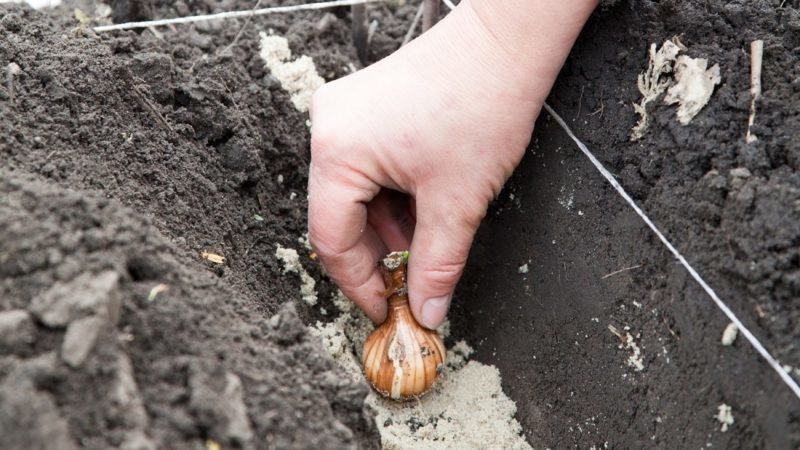
Late summer and autumn are the most suitable periods for planting tulips. Spring planting is not practiced, since the bulbs do not have enough time to take root and develop further. The plant will not be able to produce leaves and buds until cold weather sets in.
Important! The main reason for planting tulips in August is the need to stratify the bulbs. Cold testing is required for natural hardening of the plant in natural conditions and wintering without loss.
Tulips planted in August - October delight with bright and large buds and long flowering. Plants planted in spring even if they produce buds, they will not please gardeners with either beauty or size, and the shades of the petals will mostly be dull and inexpressive.
Advantages and disadvantages
Benefits of planting tulips in August:
- building a powerful root system;
- maximum supply of nutrients from the soil to the bulbs;
- safe winter;
- natural hardening of planting material;
- abundant and long spring flowering;
- wide selection of varieties.
Flaws:
- with late planting, the risk of incomplete rooting and freezing of the bulbs increases;
- damage to planting material by rodents, insect pests, pathogens of fungal and bacterial infections.
Landing dates
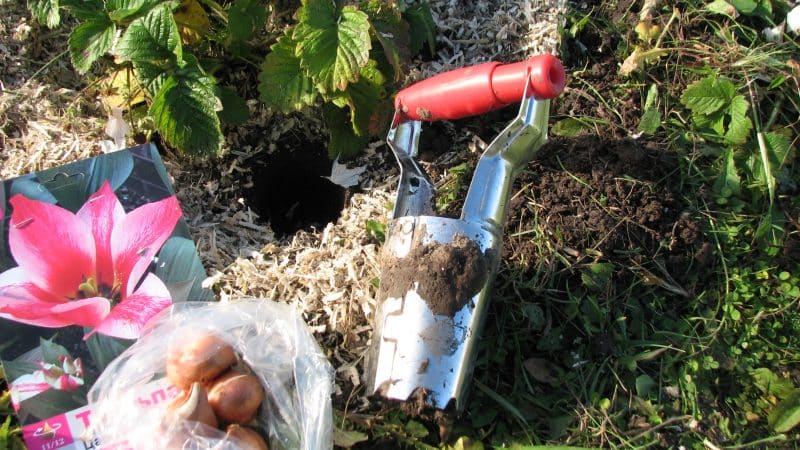
There are no exact dates for planting tulips; it all depends on the weather conditions in the growing region. As a rule, the procedure begins at the end of August and is completed in October. The rooting period of the bulbs takes 30–40 days. Therefore, gardeners recommend monitoring weather conditions to begin planting tulips before frost sets in. Planting too early is undesirable - the bulbs will germinate and die with the onset of the first frost.
Optimum air temperature for planting tulips: +15...+17°C during the day, +5...+7°C at night. The soil temperature should be +6…+10°С.
Favorable days according to the lunar calendar
Gardeners who trust the lunar calendar plant tulips during the waxing phase of the moon. It is believed that this contributes to the enlargement of the bulbs. Planting during the waning moon provokes their shrinkage.
Planting dates in 2020:
- August - 1, 2, 6, 10–12, 16, 20–26, 28, 29;
- September - 3–9, 15, 16, 19–21, 24–30;
- October - 3–6, 8–11, 13–15, 26–28;
- November - 2, 5–9, 16–19, 22, 24, 27–29.
Planting dates in 2021:
- August - 10–15, 17–19, 27–29;
- September - 1, 2, 8–12, 15, 16, 19, 20, 25, 29, 30;
- October - 7–13, 16–18, 21, 27;
- November - 2, 3, 6–10, 13, 14, 17–19.
The most successful days are considered to be the days when the Moon is in Libra and Taurus. Plants planted during this period bloom long and profusely.
This is interesting:
How to grow tulips in a pot at home
How to care for a home rose in a pot - a guide for beginner gardeners
Suitable varieties for August planting
Early tulips are suitable for planting in August; they sprout in March. Let's look at the most popular varieties:
- Candy Prince - a variety with large buds of light lilac color. Suitable for creating combined flower arrangements and is easy to care for.
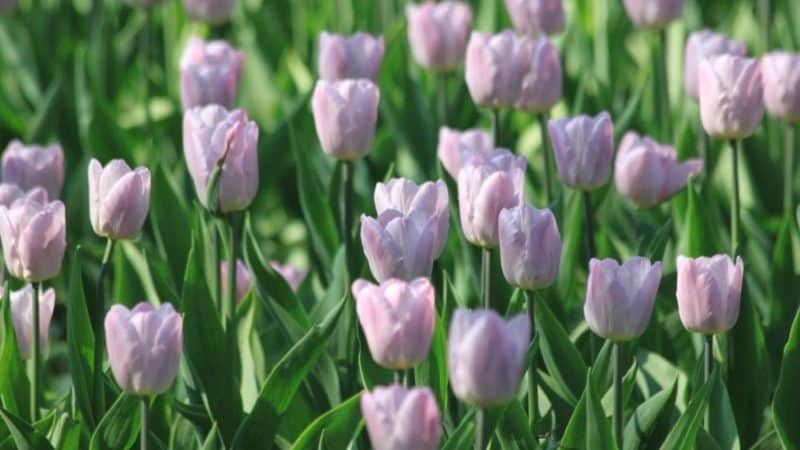 Candy Prince
Candy Prince - Monroe stands out among other varieties due to its large white or creamy-white buds, pleasant aroma and long flowering (up to 15 days). The plant reaches 20–25 cm in height.
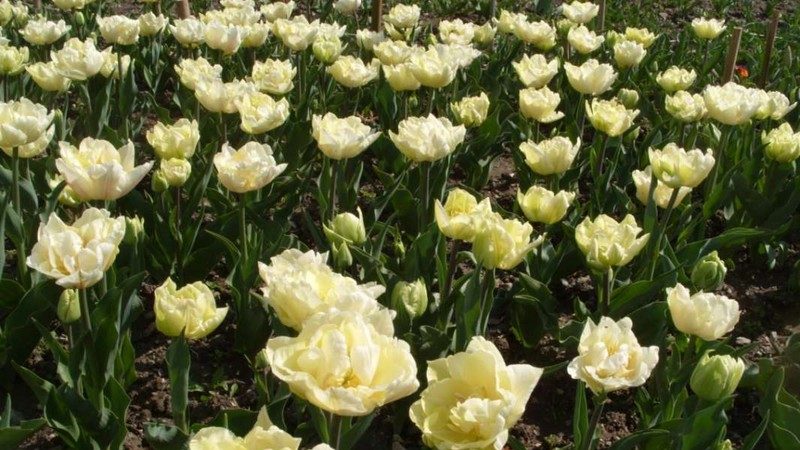 Monroe
Monroe - Monte Carlo - large buds reach 10 cm in diameter, the petals are bright yellow. Plants are resistant to diseases and temperature fluctuations.
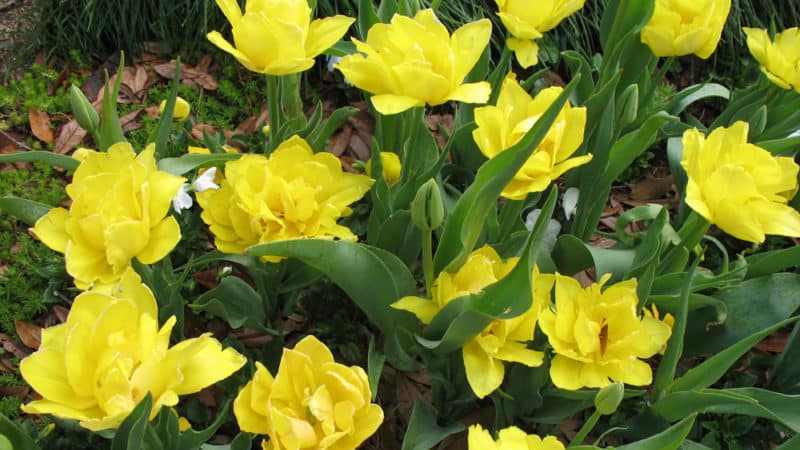 Monte Carlo
Monte Carlo
Preparatory stage
When planting tulips, it is important to choose a place for a flower bed, prepare the soil and bulbs.
Selection and preparation of site and soil
Tulips prefer illuminated areas without gusty winds and drafts with light sandy loam soil rich in humus. Heavy and sandy soil is not suitable for flowers. Clayey, clogged soil is loosened with river sand. Too poor sandy soil is fertilized with turf, humus and peat (20 liters per 1 m²).
Reference. There should be no stagnant water on the site. When groundwater is close, tulips are planted on hills or earthen embankments. To combat high groundwater levels, drainage ditches are constructed at a depth of 50 cm.
Excessive amounts of organic matter negatively affect flowering: the buds take on an irregular shape, the developing flower stalks are bent. When fertilizing the soil with fresh manure, the roots often rot, so the daughter bulbs become unsuitable for further propagation.
Plowing green manure into the soil has a beneficial effect on the development and growth of tulips.Disinfected compost has this effect. It is important that the soil has a neutral or alkaline reaction. To determine the pH of the soil, litmus strips are used, which are sold in gardening stores.
To normalize acidity, slaked lime, chalk or dolomite flour (400–500 g per 1 m²) is embedded in the soil. In addition to organic matter, the soil is fertilized with minerals that promote long-term flowering and an increase in buds. The most popular mineral additives are superphosphate (30–40 g per 1 m²), potassium sulfate (20–30 g per 1 m²), wood ash (100–200 g per 1 m²).
Selection and preparation of planting material
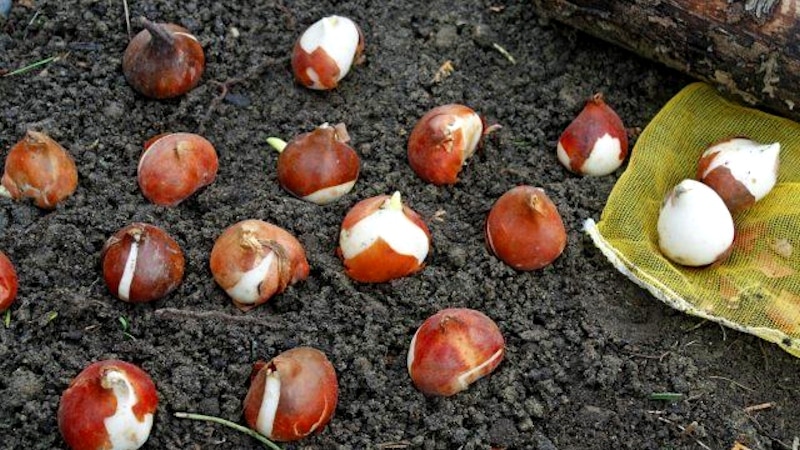
Both purchased planting material and those collected independently must be disinfected.
When choosing bulbs, pay attention to:
- size - it is better to take large specimens with a high percentage of germination compared to small ones;
- density - the bulbs should be dense and rigid;
- dried bottom - this material has excellent germination.
Sluggish planting material with the smell of rot, traces of mold and white spots should not be used for planting.
Before disinfection, the hard shell is removed from the bulbs. The material is soaked in a solution of Fundazol or potassium permanganate (5 g per 10 l) for 30 minutes.
How to plant tulips in August
When planting tulips, it is recommended to observe a number of nuances: the depth of planting the bulbs, the distance between them, crop rotation.
Step-by-step instruction
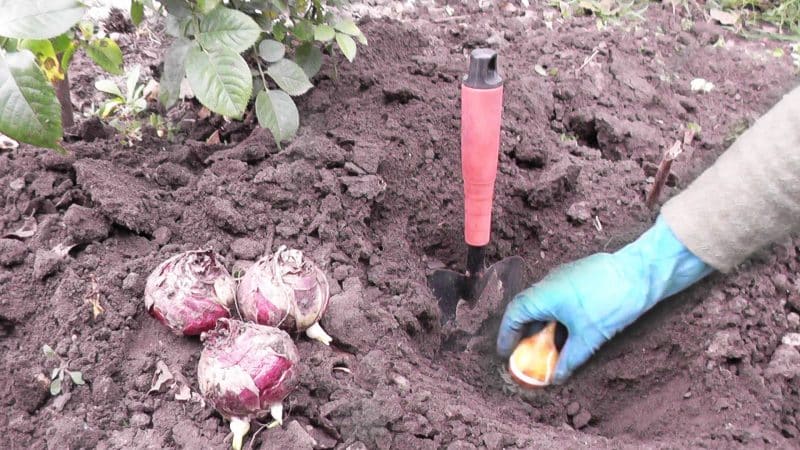
Disinfected planting material is immediately planted in prepared flower beds. It is not recommended to keep the bulbs in a swollen state for a long time due to the threat of reduced germination. Furrows with a depth of 10–15 cm are made on the site. The bulbs are planted 5–7 cm deeper in loose soil. The planting depth is influenced by the characteristics of the variety:
- bulbs of extra-class varieties are buried 15–18 cm;
- material of II-III analysis is planted to a depth of 10–12 cm;
- the children only deepen it slightly - by 5-6 cm.
Dry soil is pre-watered with warm, settled water. Fertilizer is applied to the bottom of the furrows if this was not done during plowing. A layer of river sand (4-5 cm) is poured on top. Bury the bulbs bottoms down.
The work uses a planting cone, which is convenient for making indentations, or a garden trowel. To minimize the risk of breaking roots, it is not recommended to press the material firmly into the soil. Before filling the furrows, the bulbs are dusted with wood ash.
Reference. It is important to observe crop rotation and return the plants to their original place only after 3-4 years.
Tulips are planted not only directly in the ground, but also in containers or boxes. This method is popular in many countries.
The container must be spacious. The containers are filled with a ready-made substrate for flowers, which is pre-disinfected with a solution of “Fitosporin” or potassium permanganate. The soil can also be prepared independently by mixing turf, vermiculite, humus, river sand and perlite with coconut fiber in a ratio of 4:1:1:1:1. The structure of the mixture should be loose.
Holes are dug in the area, the depth of which corresponds to the height of the container, sand is poured in and containers with substrate are placed. Prepared bulbs are planted, maintaining a distance of 5–10 cm, depending on the size of the material. A nutrient substrate is poured on top, and the area is mulched with peat or humus.
Planting pattern and depth
For planting tulips, the rule is: the depth is equal to the height of the bulb, multiplied by 3. For example, medium or large bulbs with a height of 4-5 cm are buried by 12-15 cm.
The generally accepted scheme for planting bulbous plants looks like this: the distance between the bulbs is 10–20 cm. With this placement of planting material, neighboring plants will not interfere with each other as they grow.
When to plant tulips in different regions
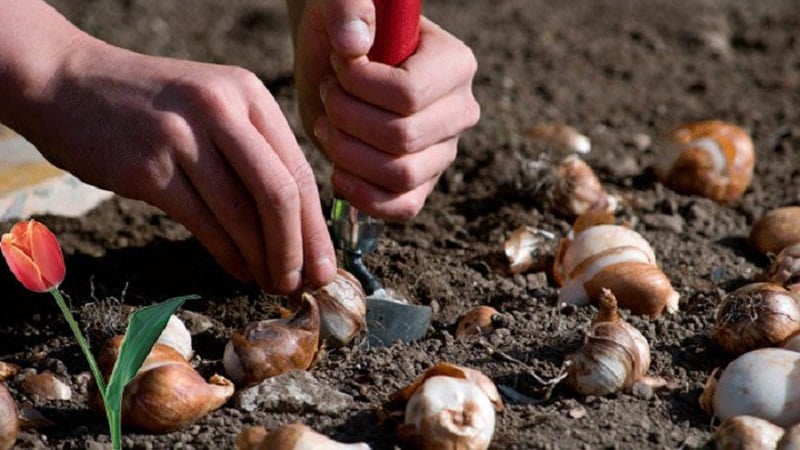
The timing of planting tulips directly depends on the climate in the region. In the middle zone of the country (Moscow region, Leningrad region), flowers are planted in mid-September - early October. In areas with short summers (Siberia, the Urals), tulips are planted in mid-August - September, when the soil temperature at a depth of 10 cm is +10°C. The area is mulched with a 10–12 cm layer of peat to protect the bulbs from early frosts.
Varieties that do not require digging for 3–5 years (Foster, Kaufman, Greig), Darwin hybrids, Triumph, simple early and late, species tulips are recommended to be planted next to varieties that are drought-resistant, perennials with shallow roots.
Planting dates in the southern regions are shifted to a later time, taking into account climate conditions. Here planting is carried out in October - November.
Conclusion
Tulips are planted primarily in the fall to allow them to take root. It is important to be in time before frost arrives and not to plant the material too early. In a favorable temperature environment, the bulbs produce roots and die when frozen. When planting, it is important to comply with the timing, focusing on weather conditions and the lunar calendar.
In the south, flowers can be planted in October - November, in the middle zone - in mid-September - early October, in Siberia and the Urals - in mid-August - September. The bulbs are buried 10–18 cm, depending on the size, in prepared furrows or in boxes or containers.